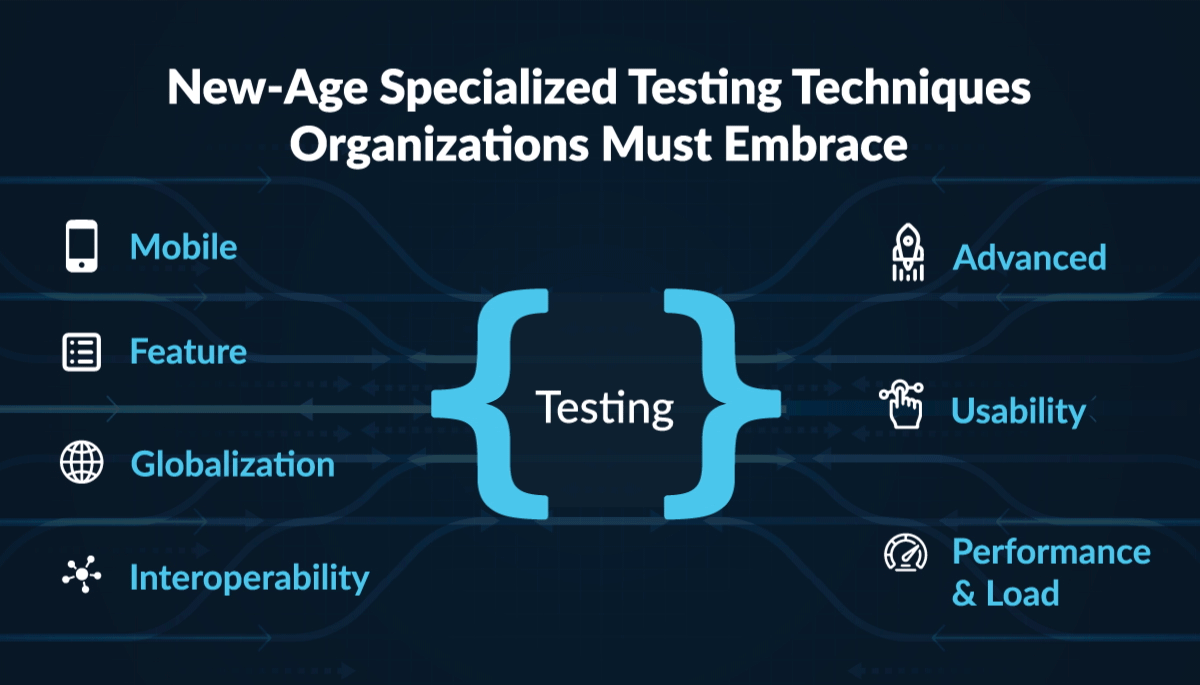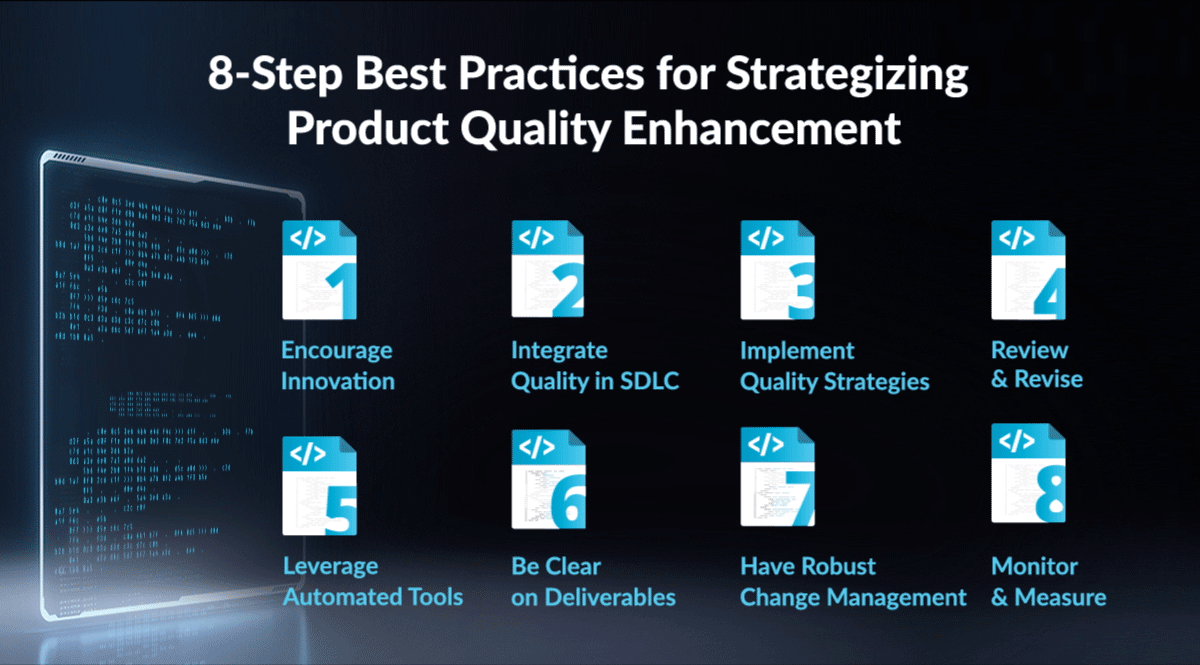



In the last part of this Specialized Testing blog series, we brought you insights on specialized testing, how software engineering teams can leverage specialized testing to help modern products enhance their quality. Moving ahead, we bring you the specialized testing strategies for modern software products.
Given how complex software products have become today, they need a modern approach to digital quality assurance. This is in addition to delivering flawless omnichannel and multi-screen web, mobile, and desktop experiences. They also need to undergo extensive testing to ensure they work just as well across the various solution ecosystems in which your product participates: from AI and ML to big data, multi-cloud, IoT, BI, and more.
For this, organizations must take an integrated approach to testing and development and embrace modern tools, processes, and frameworks to accelerate software release cycles. Using competent continuous Quality Engineering techniques and embracing an Agile approach to meet the rising expectations of digital customers, organizations can bring software quality and testing into the core engineering process - early on in the SDLC. Here’s looking at some of the new-age, specialized testing, and advanced quality engineering techniques that organizations need to embrace:
- Feature Testing: Given the melee of modern features that today’s products offer, testing each feature from a UI, multi-browser/multi-environment, database, and third-party integration perspective is extremely vital. Technology-agnostic test automation frameworks that are built for web, mobile, desktop, and API applications can accelerate the testing process, allowing teams to test their products across different requirements and integrations with third-party solutions.
These include JDBC, Slack, Jira, SauceLabs, and more. Such frameworks can not only reduce testing effort; they can also bring down run times by a large margin – all while enhancing productivity and ensuring continuous governance across the SDLC.

- Advanced Testing: As the number and complexity of software bugs and issues increase, organizations are adopting a large number of security tools and technologies to ensure their products are tested across different parameters. But using so many different competing tools can result in gaps and additional attacks, which require a totally different approach to testing.
Advanced Testing via specialized knowledge and experience can empower teams to test their products across multiple platforms and unique services. Using modern open-source tools, they can identify gaps, take preventive measures, and leverage the latest security technologies to ensure optimal product security in today’s digital era.
- Usability Testing: Today, when it comes to usability testing, teams have to go far beyond evaluating products on the experience of real-world users while using the product. They need to embrace adaptive, battle-tested algorithms that are augmented and automated with AI/ML to enable test driven-development (TDD).
By converting software requirements to test cases and repeatedly testing the software against all test cases, it allows for advanced testing of the usability of the product: right from heuristic inspection of interaction quotients to the efficiency of workflows: such testing allows for testers to create micro-interactions that optimize user experiences via behavior-driven development (BDD).
- Mobile Testing: Mobile website conversions are witnessing a 15% year-on-year increase. This is proof that software products today also need to be tested for their mobile and web browser capabilities. And this is not just limited to functionality or performance or responsiveness across different device types, operating systems (OS), and configurations.
Teams need to test products for the 3D graphics that are integrated with web and mobile interfaces and ensure the end-user experience is flawless and bug-free. They also needed to test the different OSes to ensure cross-platform consistency and retention via the use of modern plug-ins and accelerators.
- Performance & Load Testing: To test modern products on their ability to perform and withstand the load, just any tool that tests the product for availability, response time, and stability is not enough. What today’s teams need is a flexible, adaptive framework that can build iterative QE models to ensure the optimized performance of application subsystems.
Software products can be analyzed for performance under different load types. Across web-based, client-server apps, and SOA-based solutions, a framework like this can easily be set up to carry out performance tests, extract system resources like CPU, Memory, Disk, etc. and enable distributed testing and alteration of test configuration parameters - without altering scripts. Teams can get access to various reports and carry out improvement/degradation comparisons with baseline numbers.
- Globalization Testing: Since software products today are not restricted to a particular geography, demographic, or race, they need to be tested on for globalization and accessibility as well. Such testing allows teams to achieve rapid product rollouts and ensure adoption across diverse geographies with minimal source code changes.
Using globalization and accessibility testing best practices, teams can test products for inference, localized content as well as cultural awareness. They can also test applications for their assistive features and check the extent to which people with disabilities can use the application and benefit from the features.
- Product Interoperability Testing: As the IT landscape expands, software products need to be able to seamlessly interact with other apps and systems – without compatibility issues. Product interoperability testing tests products and their subsystems on their ability to communicate with other products and devices.
By carrying out tests across physical, data-type, and spec level, it allows testers to get a good idea of the product’s interoperability. In addition, testers can also test for semantic interoperability, including client environments and cross-platform / cross-vendor testing using modern plug-ins.
Customer Success Story: Interoperability Testing Ensures Ecosystem Extensibility
How to Strategize Product Quality Enhancement?
As new pressures and requirements impact team productivity daily, there’s hardly any time to ponder over the “what ifs”. Using Specialized Testing tools, teams can make the best of modern automation capabilities and maintain the right level of productivity and sanity while testing applications that are increasingly getting complex. Using successful engineering processes and innovative frameworks, it enables teams to gain insights across the SLDC and more effectively develop, enhance and support customer product lifecycles.

If you are looking to boost agility, productivity, and excellence in delivery and enable product quality enhancement via Specialized Testing, here are some best practices to follow:
- Implement Quality Strategies: One of the first steps towards successful Product Quality Enhancement is to implement quality-focused control from the start. Make quality a core element of every process, every task, and every strategy you embrace.
- Leverage Capabilities of Automated Tools: Automated tools can be of great help in the testing lifecycle; by reducing the time needed to develop test cases or carry out continuous and repetitive tests, automated tools can help boost performance while reducing the frequency and impact of risk.
- Integrate Quality Across SDLC: Use tech-agnostic automation frameworks to integrate quality across the development process. Such frameworks can not only help in ensuring quality at each phase of the development lifecycle; they can also help in faster code reviews, simplified testing, and delivering recommendations for better governance.
- Be Clear on Deliverables: Another important practice in the product quality enhancement process is to be clear on deliverables. Instead of testing products on thousands of different parameters, define customer expectations for quality upfront.
Doing this early on will help you in building internal processes and product attributes around these deliverables and put you in a better position in ensuring the necessary quality factors are being satisfied – in time and within budget.
- Encourage Innovation: High product quality does not come as a result of ticking a few testing checkboxes. It comes from encouraging innovation in a way that apps can be tested across functionality, usability, compatibility, performance, and security to flag issues like app crashes, memory leakage, and security loopholes.
- Have a Robust Change Management Process in Place: When an issue or anomaly is detected, there is a high chance that some changes will need to be made immediately to curb its repercussions. That could have an impact on other facets or the work that other teams are doing. Having a robust change management process in place will help you in making these changes seamlessly – thus reducing risks and associated costs.
- Monitor and Measure: Use modern data analytics frameworks to get insights into quality metrics. Track and report engineering metrics across the stack to act on risks and capitalize on opportunities for improvement.
- Review and Revise: No product quality enhancement strategy can be written in stone; depending on changing market situations, economic conditions, and customer needs, product changes have to be constantly made. Make it a point to review and revise your quality and testing strategies at regular intervals and make edits accordingly, so they continue to meet the requirements of the current business scenario.
Conclusion
Software quality has become a vital element of every stage of the software development lifecycle and the core responsibility of every team that contributes to the development of the product. But not many organizations actually drive continuous efforts in maintaining the quality of their products: most only carry out a series of quality checks, so the product meets a handful of basic quality requirements.
But given the competitive and highly volatile environment that organizations are operating in, there is an urgent need to lookout for ways to improve the quality of the software – not just to maintain superior performance but also to enable cost-effectiveness. Product Quality Enhancement allows teams to implement effective testing strategies as early and as often as possible, paving the way for quicker and more effective resolution of bugs and issues.
When used in combination with Specialized Testing, it allows teams a win-win scenario: customers get to enjoy products that meet requirements across mobility, accessibility, globalization, innovative features, and more while businesses get to enjoy higher growth and revenue as a result.
Make Product Quality Enhancement your mission today with Xoriant






 View Previous Blog
View Previous Blog





